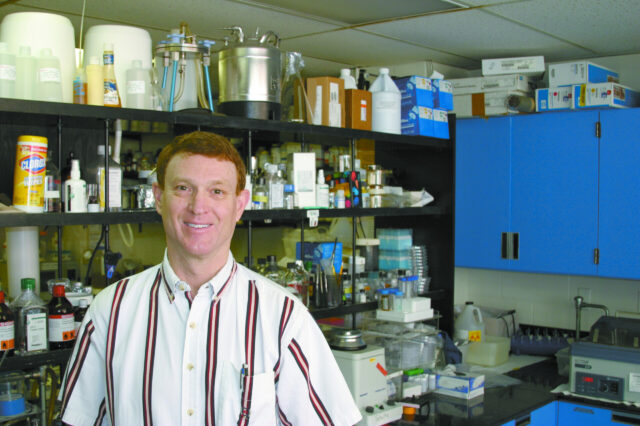UF researchers receive funds to find mustard gas treatment

University of Florida researchers have received part of an $18 million grant from the National Institutes of Health to find the best way to treat exposure to sulfur mustard gas, a chemical weapon government officials consider a serious threat to the United States.
Gregory Schultz, Ph.D., director of the UF Wound Research Institute in the College of Medicine
"Sulfur mustard is evaluated by the CIA as the most likely chemical agent to be used by terrorists," said Gregory Schultz, Ph.D., director of the UF Wound Research Institute in the College of Medicine and one of three UF researchers involved in the project. "People think of nerve agents (as a bigger threat), but they're difficult to make. If you screw up, you kill yourself. Sulfur mustard is easy to use and easy to weaponize."
There is no known treatment for sulfur mustard exposure. Used since World War I, the toxic gas rarely kills but can cause serious blistering and damage to the skin, lungs and eyes. But if Schultz is right, the answer could be a chemical developed at UF.
UF researchers will receive about $2.6 million from the grant to complete two parts of the project, a joint effort between UF, the Lovelace Biomedical and Environmental Research Institute in New Mexico and other institutions. One UF project will be to analyze data collected at Lovelace and other labs to find the drug that best blocks skin, lung and eye damage from sulfur mustard exposure. One of the drugs that will be tested is a chemical Schultz developed at UF with the Gainesville-based company Quick-Med Technologies.
This chemical has been able to block the effects of sulfur mustard exposure in rabbits and in human skin cells, according to past studies Schultz conducted with the U.S. Army and researchers at other institutions. For this project, the researchers will put the UF-developed drug and many others through more rigorous testing. These tests will all be done in a Lovelace lab equipped to safely study dangerous toxins at the Kirtland Air Force Base.
For UF's second project, Chris Batich, Ph.D., a UF professor of materials science and engineering, and Weihong Tan, Ph.D., a UF professor of chemistry, are developing a test hospitals can use to quickly detect sulfur mustard exposure in patients. The test will be similar to a pregnancy test but will use new DNA aptomer technology to detect mutations caused by sulfur mustard. This will allow hospitals to find out in about 15 minutes not only if a person was exposed but also how severe that contact was, Schultz said.
"You can't tell you have been exposed to sulfur mustard until about six to eight hours after exposure when your skin starts turning red, your eyes start burning and you start to cough," Schultz said. "It's not like inhaling acid fumes or chlorine. (The actual exposure) doesn't hurt. It's essentially painless."
But the main benefit of having a rapid test is to ensure hospitals can help the patients who need it most. If terrorists were to use sulfur mustard in an attack, leaking it in a public place for example, thousands of people could potentially flock to hospitals. A test would allow health-care workers to find out quickly who needs to be treated and who can go home, Schultz said.
The NIH funded the project for five years and by then, UF and Lovelace researchers hope to have identified at least one effective treatment for exposure, Schultz said. Some of these drugs should also be able to treat chemical injuries in the eye, he added.
Schultz has studied sulfur mustard injuries for years, but the key to finding a treatment is the partnership between UF and Lovelace, one of the country's largest independent research institutions, said Gary Grotendorst, a senior scientist in the respiratory immunology and asthma program at Lovelace.
"We wanted to have a comprehensive research program that would investigate sulfur mustard injury to the three major organs that are affected - the lungs, skin and eyes," Grotendorst said. "Dr. Schultz's experience and expertise allow us to have such a multi-dimensional research program."